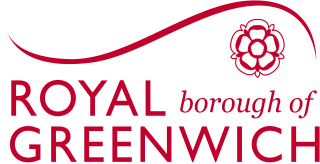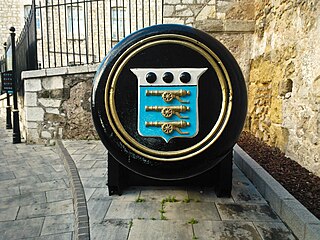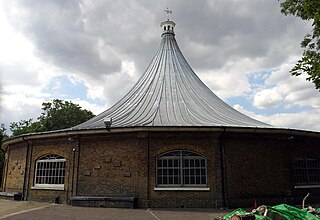History of the building
The Greenwich Heritage Centre was in the western and southern range of a quadrangle of buildings known as New Laboratory Square or Building 41, a former storehouse designed by James Wyatt, dating from 1783 to 1785. The storehouse was built by the Board of Ordnance as a "sea storehouse" (a repository for naval ordnance supplies). Further storehouses were added to form the north and east sides of the square in 1808–10. By 1860 the whole complex had been taken over by the Royal Laboratory department and converted into a factory to make boxes and barrels for the storage and carriage of ammunition, powder, cartridges, fuses and other items; the west range contained the wood store, the east range had a sawmill with a cooperage above it, the north range contained a steam engine, which powered the machinery by way of line shafting.
The entrance of the Greenwich Heritage Centre was in the south wing of the quadrangle, a former carpenters' workshop of 1877-78 where boxes and barrels were machine-assembled. By the time of the First World War this space had been given over to the manufacture of ammunition for small arms. At the end of the war many women were at work here. In the years leading up to the closure of the Arsenal in 1994, much of the building was in use as Customs and Excise stores. [2]
Detail of the south range of New Laboratory Square
The west range and the back of the Old Royal Military Academy
East and north range; currently not in use by the museum
East range; barrels would leave the first-floor by way of the round hole (left)
History of the museum and closure
The Greenwich Heritage Centre was established in October 2003, combining collections from the Greenwich Borough Museum and the local history library, previously at Woodlands House in Westcombe Park. [3] The establishing of a museum of local history in this area was motivated by the council's desire to support the refurbishment of the Royal Arsenal and make it a desirable place to live and visit. It was preceded in 2001 by the move of the Royal Artillery Museum from its historic location at the Rotunda to a disused building at the Arsenal where it took the name Firepower – The Royal Artillery Museum.
New Laboratory Square was restored by English Partnerships and the London Development Agency in 1999–2002, after plans by Llewyn-Davies architects. Initially the museum only used the west range of the building, while sharing the south range with Firepower. The rest of the building was used as storage by Firepower until its closure in 2016. [4]
In 2014 a new charity, the Royal Greenwich Heritage Trust (RGHT), was formed to manage the museum and archives as well as Charlton House, The Tudor Barn in Eltham and certain other heritage assets in the Borough. The RGHT is supported by the Friends of the Royal Greenwich Heritage Trust.
In 2017 it was announced that the borough had plans to create a £31 million creative district around the riverside end of No 1 Street. The plan includes a 1200-seat auditorium for concerts and events in Building 41. [5]
The closure of the centre in July 2018 was criticised as being sudden and without consultation, with unclear plans as to its future, [6] although the Trust said it planned to continue its research. It moved the borough's archives and museum collections into a single store in the Anchorage Point Industrial Estate on Anchor and Hope Lane in the Woolwich Dockyard area in the following years [7] [8] and - though that facility's opening has been delayed by the COVID-19 pandemic - it is to remain unaffected by a new school planned for the road unless road improvement works follow. [9] [10]
Exhibitions
From the opening of the museum there was a permanent exhibition named Inside the Arsenal, which told the history of the Royal Arsenal (and the nearby Woolwich Dockyard). A section of this exhibition was entitled Here Come The Girls, celebrating the role of women in wartime Woolwich, particularly during the First World War. [11]
In 2016, following the closure of the Firepower museum across the road, a second permanent exhibition Making Woolwich: The Royal Regiment of Artillery in Woolwich was set up to fill the gap. This exhibition was in the south wing of the building marked the 300th anniversary of the formation of the Royal Regiment of Artillery in Woolwich in 1716. Even though the main theme was the Royal Artillery, some of the objects on display related to the Royal Military Academy, Woolwich (1741-1939).
Apart from these, the museum usually had one or two changing exhibitions per year. These generally focused on a specific area in the borough, a historic event or other topics of local interest. The temporary Berkeley Gallery was replaced by the Making Woolwich exhibition.
Reception area. To the right the former Berkeley Gallery
Local history section. Stairs to first floor
Permanent exhibition Inside the Arsenal
Permanent exhibition Making Woolwich

The Royal Borough of Greenwich is a London borough in southeast Greater London. The London Borough of Greenwich was formed in 1965 by the London Government Act 1963. The new borough covered the former area of the Metropolitan Borough of Greenwich and part of the Metropolitan Borough of Woolwich to the east. The local council is Greenwich London Borough Council which meets in Woolwich Town Hall. The council's offices are also based in Woolwich, the main urban centre in the borough.

Woolwich is a district in southeast London, England, within the Royal Borough of Greenwich.

Greenwich is a town in south-east London, England, within the ceremonial county of Greater London. It is situated 5.5 miles (8.9 km) east-southeast of Charing Cross.

The Board of Ordnance was a British government body. Established in the Tudor period, it had its headquarters in the Tower of London. Its primary responsibilities were 'to act as custodian of the lands, depots and forts required for the defence of the realm and its overseas possessions, and as the supplier of munitions and equipment to both the Army and the Navy'. The Board also maintained and directed the Artillery and Engineer corps, which it founded in the 18th century. By the 19th century, the Board of Ordnance was second in size only to HM Treasury among government departments. The Board lasted until 1855, at which point it was disbanded.

Charlton is an area of southeast London, England, in the Royal Borough of Greenwich. It is east of Greenwich and west of Woolwich, on the south bank of the River Thames, 7.2 miles (11.6 km) southeast of Charing Cross. An ancient parish in the county of Kent, it became part of the metropolitan area of London in 1855 and is home to Charlton Athletic F.C. and Charlton House.

The Royal Arsenal, Woolwich is an establishment on the south bank of the River Thames in Woolwich in south-east London, England, that was used for the manufacture of armaments and ammunition, proofing, and explosives research for the British armed forces. It was originally known as the Woolwich Warren, having begun on land previously used as a domestic warren in the grounds of a mid-16th century Tudor house, Tower Place. Much of the initial history of the site is linked with that of the Office of Ordnance, which purchased the Warren in the late 17th century in order to expand an earlier base at Gun Wharf in Woolwich Dockyard.

Woolwich Common is a common in Woolwich in southeast London, England. It is partly used as military land and partly as an urban park. Woolwich Common is a conservation area. It is part of the South East London Green Chain. It is also the name of a street on the east side of the common, as well as an electoral ward of the Royal Borough of Greenwich. The population of the ward at the 2011 Census was 17,499.

The Royal Artillery Museum, which was one of the world's oldest military museums, was first opened to the public in Woolwich in southeast London in 1820. It told the story of the development of artillery through the ages by way of a collection of artillery pieces from across the centuries.

Woolwich Garrison is a garrison or station of the British Army. Geographically it is in Woolwich, in the London Borough of Greenwich. In terms of command, it is within the Army's London District.

The Royal Arsenal Co-operative Society (RACS) was a large consumer co-operative based in south east London, England. The co-operative took its name from the Royal Arsenal munitions works in Woolwich and its motto was: "Each for all and all for each". In 1985 it merged into the national Co-operative Wholesale Society.

Charlton House is a Jacobean building in Charlton, within the Royal Borough of Greenwich in south-east London. Originally it was a residence for a nobleman associated with the Stuart royal family. It later served as a wartime hospital, then a museum and library, and is now a community centre.

Charlton Riverside, previously known as New Charlton, is the area along the south bank of the river Thames at Charlton, London, which forms part of the Royal Borough of Greenwich. It was formerly a primarily industrial zone, known for the glass and rope making industries, but is now an area of regeneration.

Woolwich Town Hall is an early 20th-century town hall located in the historic Bathway Quarter in the centre of Woolwich, South East London. Until 1965 it was the seat of local government of the Metropolitan Borough of Woolwich, after which it became the headquarters of the Greenwich London Borough Council. It is a rare example of an Edwardian Baroque town hall in London and is a Grade II*-listed building.

St Peter's Church is a Roman Catholic church in Woolwich, South East London. It is situated between Woolwich New Road and Brookhill Road, the main entrance being on Woolwich New Road. The church was designed by Augustus Pugin in 1841–42 in the style of the Gothic Revival and is one of only three Pugin churches in London. Pugin's design remained unfinished as the projected tower and spire were never built. The parish of St Peter the Apostle serves the Catholic community of central Woolwich and surrounding areas, and is part of the Archdiocese of Southwark which is in the Province of Southwark.

St George's Garrison Church is a ruined church in Woolwich in the Royal Borough of Greenwich, South East London. It was built in 1862-63 as a Church of England place of worship for the Woolwich Royal Artillery garrison. The church was hit by a V-1 flying bomb in 1944 and largely destroyed by fire. The restored ruin with its canopied roof, its blue, red and yellow brick walls, its mosaics and a memorial garden is open to the public on Sundays.

The Royal Arsenal Gatehouse or Beresford Gate is the main gatehouse of the Royal Arsenal in Woolwich in the Royal Borough of Greenwich, South East London, England. It was built in 1828, enlarged several times and is now a Grade II-listed building. The gate was named after the Anglo-Irish general William Beresford, Master-General of the Ordnance and Governor of the Royal Military Academy in Woolwich.

Beresford Square is a pedestrianised town and market square in Woolwich in the Royal Borough of Greenwich in London, England. It was formed in the early 19th century and was named after the Anglo-Irish general William Beresford, Master-General of the Ordnance and Governor of the Royal Military Academy in Woolwich. With its lively street market and lined with shops, pubs and restaurants, Beresford Square has been the heart of Woolwich for over two centuries. Since 2019 the square is part of a conservation area.

Powis Street is a partly pedestrianised shopping street in Woolwich in the Royal Borough of Greenwich, south-east London, England. It was laid out in the late 18th century and was named after the Powis brothers, who developed most of the land in this part of the town. The street has been rebuilt several times but has retained some notable examples of late-Victorian and Art Deco architecture. Since 2019 the street is part of a conservation area.

Old Woolwich or Woolwich Central Riverside is an area along the Thames in Woolwich, South East London. It is the oldest inhabited part of Woolwich, going back to an Anglo-Saxon riverside settlement. When the demographic centre of Woolwich shifted south in the 1800s, the area became a Victorian slum. Most of Old Woolwich was cleared in the 20th and early 21st centuries to make way for industrial, infrastructural and other large-scale developments. Although most of the earlier buildings have been demolished, the area has retained some interesting architecture, including the Georgian parish church, the Edwardian foot tunnel rotunda and two cinemas of the 1930s.

Woolwich Works, also known as Woolwich Creative District, is a multi-disciplinary cultural venue on the south bank of the River Thames in Woolwich in southeast London, that opened in September 2021.



























